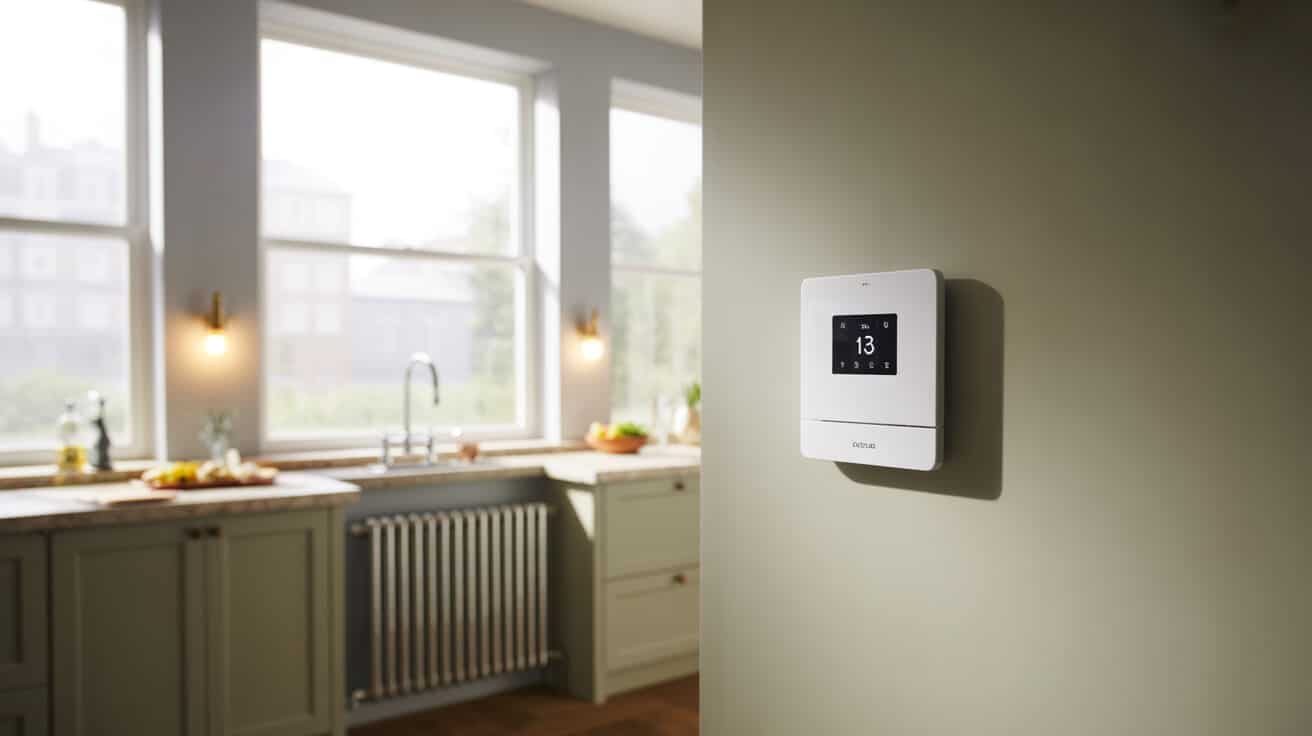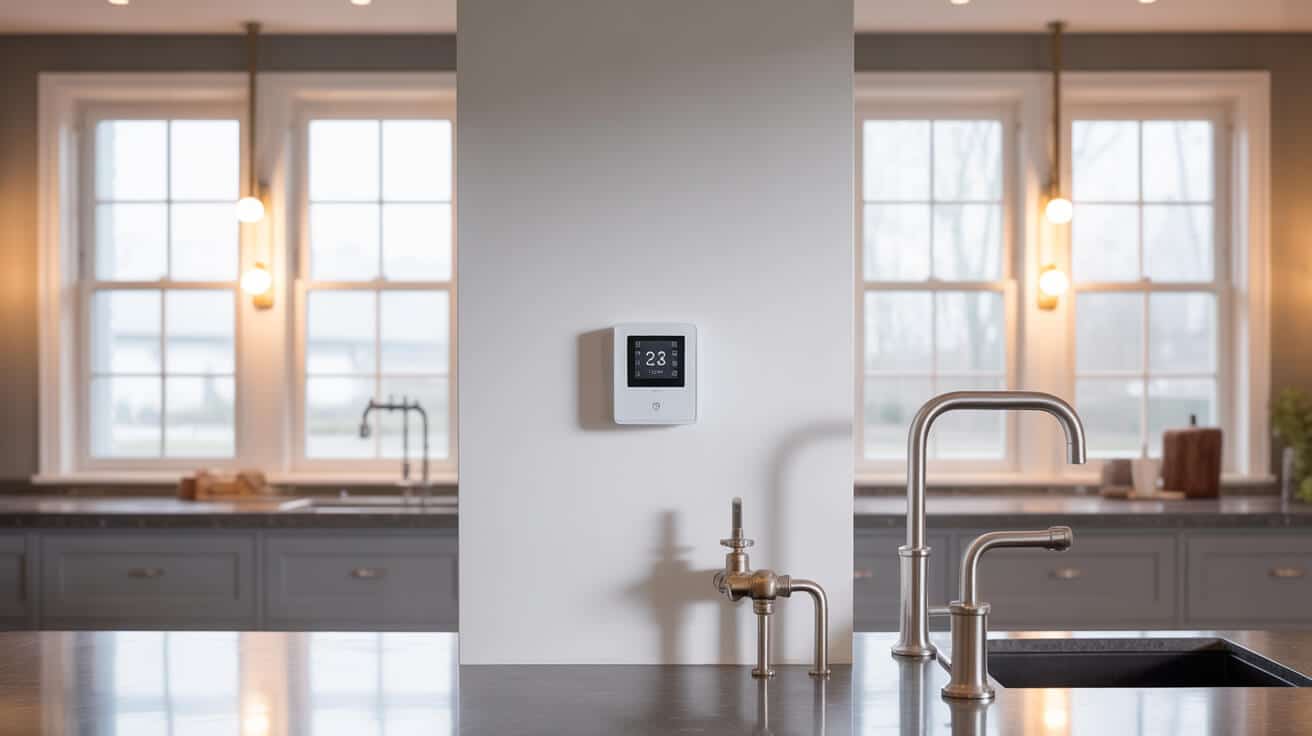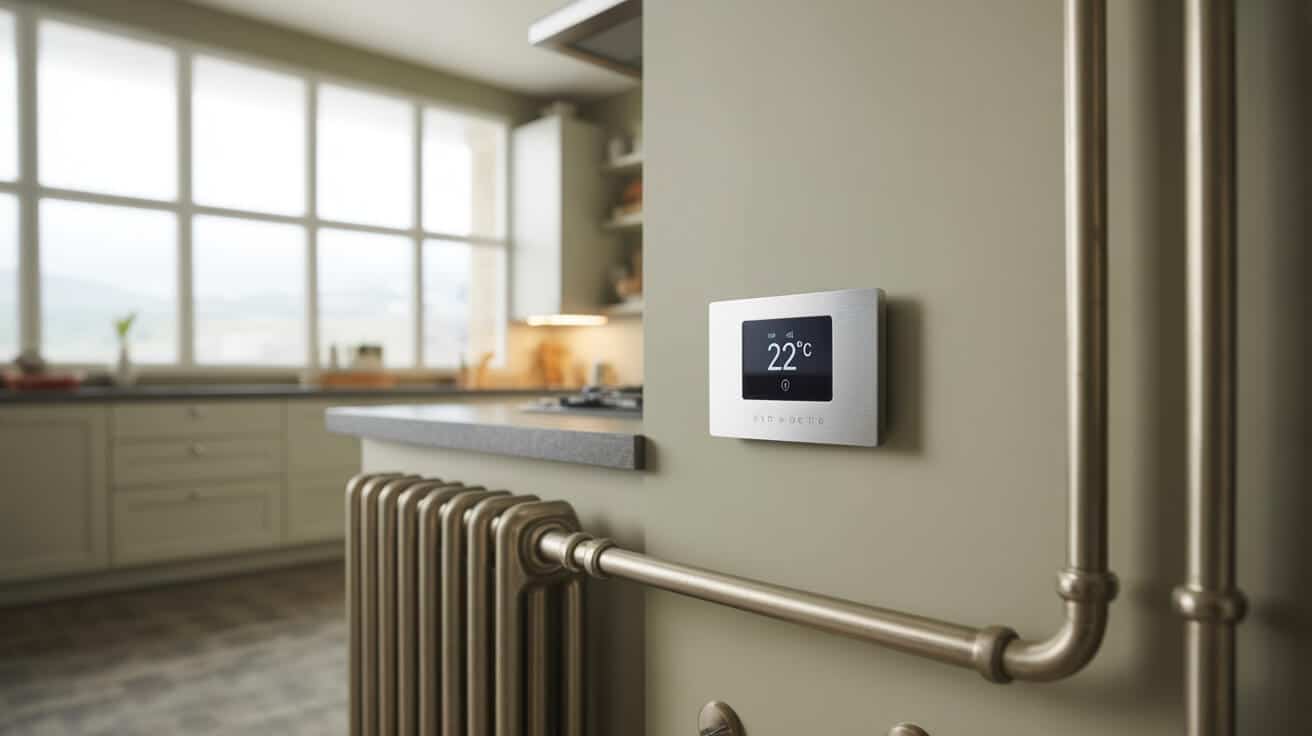Programmable digital thermostats bridge the gap between comfort, efficiency, and regulatory compliance in property management and domestic settings. By allowing scheduled temperature adjustments, these devices minimise energy waste and enhance system responsiveness, supporting a diverse portfolio of heating applications. Plumbers 4U leverages such devices as essential components of your comfort infrastructure, focusing on optimised installation, reliable support, and targeted user education to address the distinctive needs of you and your property.
Etymology or name origin
The term “thermostat” derives from the Greek words “thermos,” meaning heat, and “stat,” relating to stability or keeping constant. Early thermostats encapsulated this concept by holding temperatures steady, typically via mechanical means. The qualifier “programmable digital” emerged in the late twentieth century, denoting the shift from analogue, single-point controllers to devices capable of storing complex user-defined routines, all regulated by embedded digital processing.
Overview and context
Programmable digital thermostats serve as the chief control interface between occupants and their heating systems. They empower your household or commercial space to maintain tailored comfort levels while reducing resource consumption. Regulatory environments, such as the United Kingdom’s Boiler Plus and Building Regulations (Part L), increasingly designate these control systems as standard for energy-conscious assets. For property owners and landlords, such thermostats play a role in compliance and risk minimization, defining standards for tenant comfort and cost management. Within managed sites, facilities directors rely on programmable control layers to streamline multi-zone programming and diagnostics, minimising downtime and complaint-related interventions.
Key functions and integration domains
- Temperature scheduling:
User-set timetable (daily, weekly, or custom blocks) for desired setpoints.
- Manual override:
Temporary temperature changes, with automatic return to schedule.
- Lock-out/security:
PIN protection or restricted access for shared or tenanted premises.
- Display and UI:
LCD, touchscreen, or tactile buttons for intuitive configuration.
- Integration:
System compatibility (boiler, underfloor, heat pump), multi-zone, and advanced protocols (e.g., OpenTherm).
History
Early temperature regulation
Initial thermostatic control devices used physical expansion of materials—mercury, bimetallic strips, bellows—translating ambient temperature into mechanical switching. These systems were limited to a single, manual setpoint without scheduling.
Advent of electronic controls
By the mid to late twentieth century, the emergence of digital timers and electronic relays brought new programmable solutions to heating control. Early domestic units appeared in premium housing and institutional environments, offering fixed period programming, modest interface complexity, and increased temperature accuracy compared to mechanical predecessors.
Modern evolution and integration
The 1990s and early 2000s witnessed the proliferation of microcontroller-driven thermostats, standardised LCD panels, streamlined interfaces, and deeper schedule memory capacity. Modern devices are now expected to feature adaptive start, holiday modes, PIN protection, and robust user feedback. Growth in energy standards (e.g., Boiler Plus, Energy Performance Certificates) further accelerated innovation, as did rising demand for multi-zone management and compatibility across heating system types.

Concept and description
Programmable digital thermostats function as discrete, autonomous controllers connected physically or wirelessly to your heating apparatus. Sensors monitor room temperature, feeding data into the thermostat’s microprocessor. Embedded scheduling logic matches this data against your predefined comfort routine, deciding when to activate or deactivate heating circuits. Most devices include a user interface—buttons, dials, or touchscreen—enabling intuitive process adjustment. Relays or solid-state outputs control the heating device. Additional features may include:
- Adaptive learning:
Anticipates pre-warming needs based on recent patterns or outside temperature.
- Holiday and boost modes:
Easily set temporary schedules for extended absences or sudden requirements.
- Multi-zone configuration:
Assigns specific settings to different rooms or property segments.
- Accessibility adjustments:
Large text displays, simple icons, and tactile markers for users needing clear cues.
Primary system layers
| Layer | Function |
|---|---|
| Sensor/Input | Monitors ambient or target temps. |
| Processor/Logic | Compares, computes, and decides. |
| Interface/UI | Displays, enables scheduling. |
| Output/Relay | Switches heating/cooling devices. |
Functionality, purpose, and applications
The primary purpose of a programmable digital thermostat is to optimise your environment’s heating performance, aligning comfort with occupancy and minimising waste. In practice, these devices enable:
- Scheduled comfort: Maintain daily comfort for work, sleep, and absence with preset programmes.
- Automatic savings: Reduce fuel and maintenance costs by scaling back heating during unoccupied periods.
- Compliance enforcement: Provide documentary evidence and features to assist you with meeting landlord or facility regulatory requirements.
- Multi-system flexibility: Seamless operation across combi boilers, system boilers, underfloor heating, and hybrid installations.
Use-case scenarios
- Homeowners: Experience consistent warmth at desired hours, minimise manual adjustment, avoid excessive fuel bills.
- Landlords: Ensure conformity with legal obligations, reduce complaint risk, demonstrate provisioning of efficient controls during regulatory checks.
- Property managers: Integrate control of multiple units, automate reporting and maintenance scheduling.
- Facilities directors: Centralise system diagnostics, streamline override authority, enable rapid adaptation to environmental or tenant changes.
Classifications, types, and variants
Programmable digital thermostats are categorised by installation approach, system application, feature set, and compliance status.
By installation type
- Wired thermostats:
Require direct connection to the heating system, typically suited for new builds or properties where cable runs are accessible.
- Wireless (RF) thermostats:
Employ radio communication between thermostat and receiver. Popular in retrofit scenarios, multi-zone deployments, or historic properties with inaccessible wiring routes.
By application
- Combi boiler compatible:
Designed to interface with heating-only apparatus, managing both mode change and setpoint temperature.
- System and regular boilers:
Multi-channel capability controls both central heating and domestic hot water circuits, common in UK homes.
- Underfloor heating controls:
Offer multiple sensor inputs, ranging from air to floor probes, and allow segmented programming per room or manifold.
By feature set
- Basic programmable:
Provide weekday/weekend or 7-day programming and manual override; suited for simple, single-zone installations.
- Advanced programmable:
Include adaptive algorithms, PIN logins, multiple profiles, memory retention during power interruptions, and multi-zone interfaces.
- Specialised compliant:
Certified for legal environments with mandatory PIN-locks, visible compliance indicators, and event logging for audit purposes.
By compliance and manufacturer
Thermostats must often comply with standards such as BS EN 60730-2-9 (automatic electrical controls), and regional energy directives. Manufacturers (Honeywell, Drayton, Heatmiser, Danfoss, Salus, among others) provide a wide array of models with industry-specific features.
Systems, tools, and methodologies
System integration
A programmable digital thermostat is frequently integrated with:
- S-Plan and Y-Plan valve systems: Managing flow to radiators, underfloor zones, or hot water cylinders via direct valve actuation.
- OpenTherm or proprietary protocols: Allowing granular control over boiler firing rates, optimising both comfort and efficiency.
- Zoning kits/manifolds: Enable custom programming for individual spaces, ideal in communal residences or office complexes.
Tools and commissioning
Installers use a standardised toolset, including:
- Multimeters: , voltage testers, and continuity buzzers, ensuring proper terminal identification and safe low/high voltage separation.
- Mobile configuration apps: (where supported), streamlining commissioning and diagnostic output.
- Quick-reference programming cards and mounting templates: Minimise errors during setup.
Maintenance and user assistance
- Batteries: Wireless models may need periodic battery replacement, with low-battery warnings to prevent dropouts.
- Cleaning/interface care: Regular gentle cleaning of screens and buttons ensures long-term performance.
- Troubleshooting guides: Comprehensive documentation, video resources, and client handover packs (often a hallmark of Plumbers 4U) reduce end-user confusion and field complaints.

Stakeholders and entities involved
Stakeholder involvement in programmable digital thermostat deployment is broad and segmented:
- Homeowners: Primary operators, benefitting from direct control and cost savings.
- Landlords: Hold legal responsibility for providing and maintaining compliant, secure controls in rental units.
- Property/facilities managers: Oversee procurement, commissioning, bulk programming, and maintenance integration.
- Installers/engineers: Ensure correct installation, meet certification requirements, and educate all user types.
- Manufacturers and regulators: Supply accreditation, regular updates, and training for evolving products and compliance landscapes.
The efficient collaboration across these groups, facilitated by clear standards and well-documented product support, is key to maximising installation quality and system longevity.
Legal, regulatory, and ethical considerations
Regulatory landscape
- United Kingdom: Adoption of Boiler Plus and Building Regulations Part L (Conservation of Fuel and Power) mandates specific features (e.g., programmable controls, load compensation) in all new and replacement heating systems.
- Standards: Devices must comply with BS EN 60730-2-9 for electrical and control safety.
Installer and landlord obligations
- Qualifications: All installations must be executed by competent, certified professionals (e.g., Gas Safe, OFTEC for oil systems, WaterSafe for potable applications) to satisfy statutory and insurance criteria.
- Documentation: System commissioning and user training must be logged, with compliance documentation provided to tenants or property owners.
- Privacy/access: PIN and access codes, child locks, and role-specific settings ensure ethical use, preventing restriction of comfort for vulnerable residents.
Landlord and tenant dynamics
Landlords are legally obliged to provide effective, accessible heating controls for tenants, with configuration security in multi-user environments. Failure to comply exposes landlords to financial and legal penalty, including voiding insurance in the event of damage or tenant complaints.
Performance metrics, data, and measurements
Technical performance
- Temperature accuracy:
High-grade sensors and rapid refresh rates ensure heating systems maintain within tight tolerances.
- Scheduling flexibility:
Range of permissible programme slots, rapid override transitions, and memory retention following power loss.
- Energy impact:
Studies indicate 10–20% savings in energy consumption compared to manual, unprogrammed operation, provided schedules are optimally configured.
- Reliability:
Metrics include mean time between failure (MTBF), frequency of support callouts, and firmware update efficacy.
Usability
| Feature | User Profile | Typical Outcome |
|---|---|---|
| Adaptive scheduling | Homeowners | Higher comfort, lower effort |
| PIN lock/config logs | Landlords, managers | Secure, auditable operation |
| Multi-zone mapping | Facilities directors | Centralised asset control |
| Guided help packs | All | Reduced confusion, fewer errors |
Challenges, barriers, and limitations
Operational and technical
- Mismatched voltage:
Incompatible wiring between old controls and new digital thermostats is a frequent stumbling block.
- Wireless range issues:
RF systems may face interference in larger or steel-frame properties, necessitating repeaters or alternate placement.
- Complexity:
Some advanced models overwhelm less tech-savvy users, leading to frequent manual overrides or inadvertent disablement of savings features.
Social and economic
- Initial cost:
While programmable models typically pay for themselves over time, upfront price can discourage adoption in cost-sensitive sectors.
- Tenant education:
Frequent turnover necessitates repeated training, especially in social housing or managed portfolios.
- Access and equity:
Accessible user interfaces—large displays, simple text, contrast, or language options—remain inconsistent, inhibiting adoption among elderly, visually impaired, or non-English speakers.
Behavioural
- Automation scepticism:
A subset of users distrusts automated routines, either preferring manual control or expressing concern over perceived loss of autonomy.
- Tamper resistance:
While lockout features prevent configuration changes, they can also result in dissatisfaction when not clearly communicated or easily overridden by authorised parties.
Impact, influence, and legacy
The programmable digital thermostat stands as a significant innovation in the ongoing evolution of property management, heating control, and environmental stewardship.
- Reduced energy consumption:
Large-scale adoption has influenced utility usage patterns, reduced peak load, and formed an integral part of national energy efficiency strategies.
- Cultural shift:
Controlled environments have transitioned from luxury to expectation, with modern households and workplaces viewing accurate, automated comfort control as a baseline standard.
- Market transformation:
The sector has been irreversibly altered, with manufacturers, service providers such as Plumbers 4U, and regulatory bodies constantly investing in refinement and education.
Future directions, cultural relevance, and design discourse
Technological advances
Emerging design trends focus on adaptive learning, granular zoning, and cognitive interfaces that anticipate user needs. Enhanced integration with broader building management systems allows seamless adaptation to your property’s occupancy and environmental changes. There is a shift towards context-aware interfaces, clearer visual or tactile cues, and continuous firmware innovation.
Policy and compliance development
Standards continue to be elevated, demanding greater granularity in scheduling, audit trails for professional users, and explicit accommodation for vulnerable user groups.
Developments in remote commissioning, compliance documentation, and smart grid participation will further elevate the significance of expert installation and tailored support.
Societal impact and accessibility
Cultural attitudes toward programmable digital thermostats reflect an increasing expectation for both simplicity and inclusivity.
Discourse has shifted from viewing controls as mere hardware to recognising their role in user autonomy, energy ethics, and the psychological comfort conferred by predictable, reliable environments.
As population demographics shift, and as Plumbers 4U and similar service providers encounter a more diverse user base, design priorities will increasingly encompass universal design, easy handover protocols, and proactive support infrastructures—all contributing to an enduring, evolving legacy.

